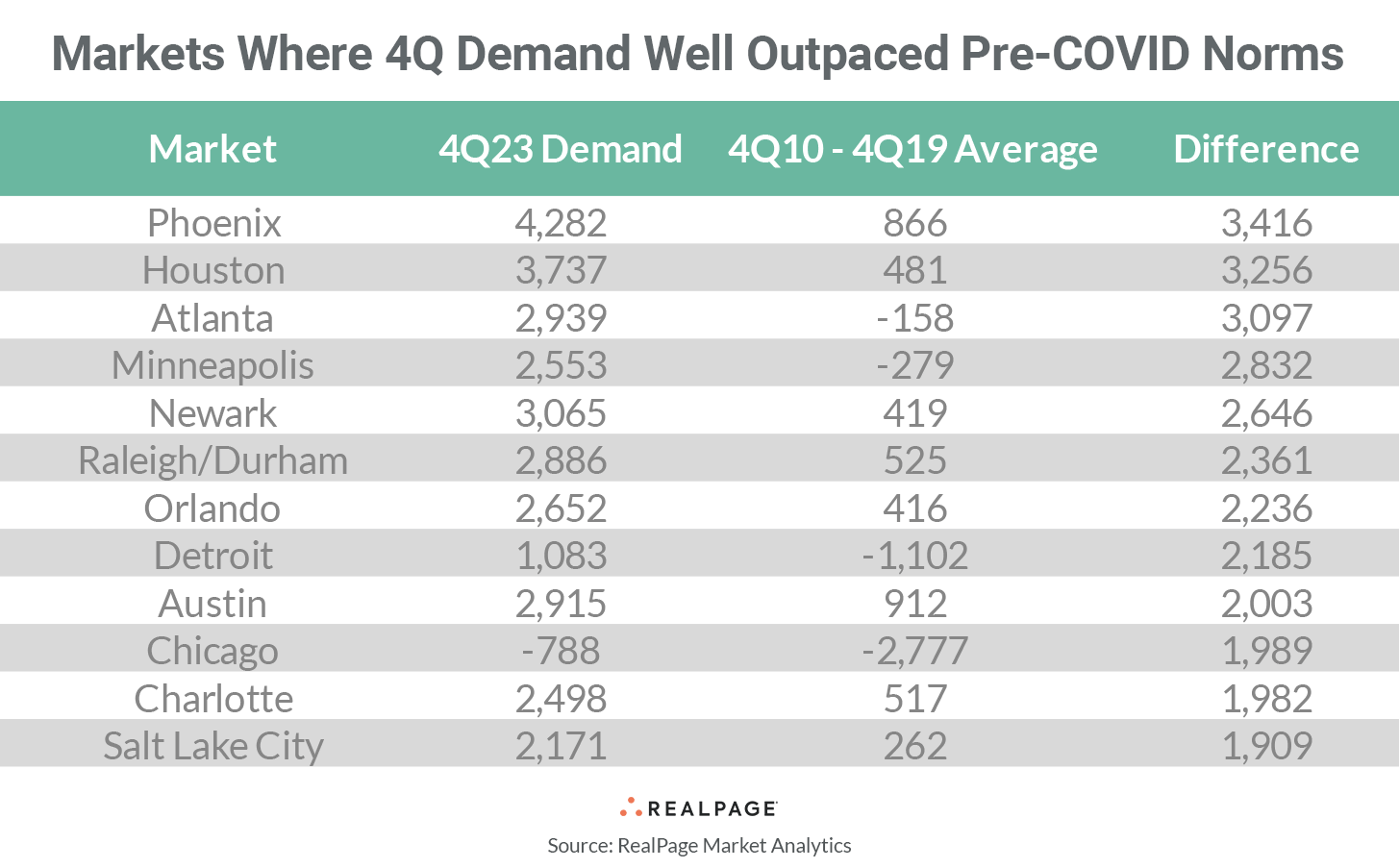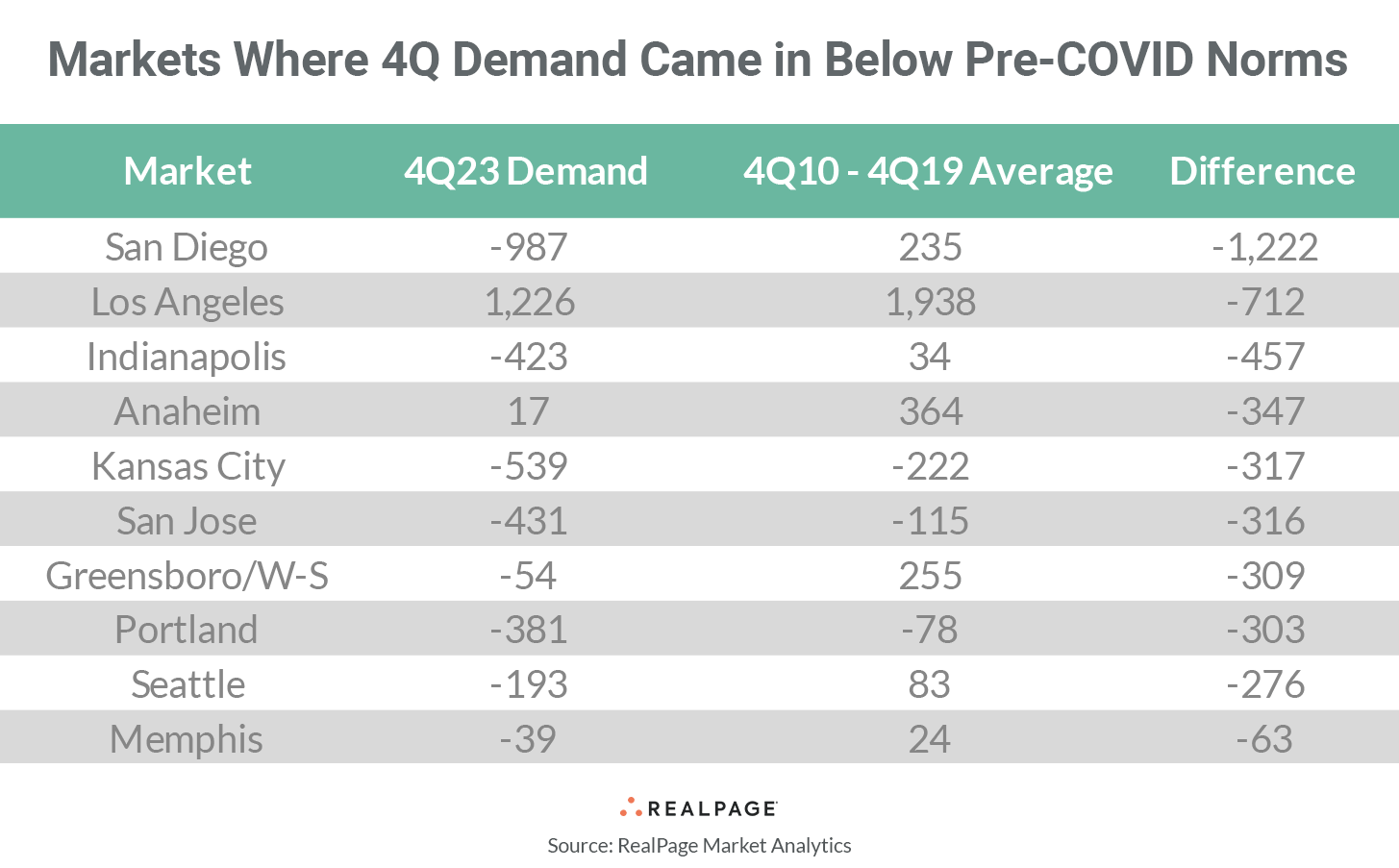U.S. apartment demand in 4th quarter was solid, and some markets saw significantly improved performances compared to pre-COVID norms.
Geographically, most of these outperforming apartment markets were in the Sun Belt, which has seen solid population growth in recent years, bolstering household formation and demand for all types of housing. Most of these markets are also top performers for job growth nationwide and have seen sizable new completion volumes.
These weren’t the only markets logging strong demand in 2023’s final quarter. In fact, most major U.S. apartment markets saw a big demand rebound in 4th quarter 2023 and, in fact, a final quarter demand performance that surpassed the long-term average. In these 12 markets, however, 4th quarter 2023 demand most severely outperformed the long-term demand norm (by at least 1,900 units), according to data from RealPage Market Analytics.
Phoenix was one of the nation’s top apartment demand performers in calendar 2023, buoyed notably by absorption of nearly 4,300 units in the last three months of the year. In comparison, 4th quarter demand in Phoenix averaged less than 900 units in the decade leading up to the pandemic (2010-2019). The momentum this market managed to drum up in 2023 brought some relief after demand plunged in 2022. Driving the return of demand was a strong job market, as this is one of the few markets located outside of the South region to lead the nation in employment growth in the past five years. New supply volumes, however, were also nation-leading, and that full supply pipeline is scheduled to continue into 2024.
Houston and Austin were the Texas markets that saw notable demand recovery at the end of 2023. Like Phoenix, these markets also were among the nation’s leaders for both job growth and new supply additions in the past five years. In fact, Austin also ranked among the nation’s leaders in percentage job change in that time frame.
Markets that averaged net move-outs in 4th quarter during the 2010-2019 timeframe include Atlanta, Minneapolis, Detroit and Chicago. In fact, Chicago is still seeing net move-outs in 4th quarter 2023. The pace of loss in the Windy City, however, is significantly less than what the market typically saw before the pandemic.
Detroit didn’t record as strong demand as the other markets on this list, but roughly 1,100 units of demand in 4th quarter 2023 was significantly ahead of the net move-outs for about 1,100 units the market saw on average in the last three months of the year during the 2010 through 2019 time frame.
Only a handful of apartment markets logged 4th quarter demand in 2023 that came in below pre-COVID averages. These were mostly West region markets and metros lacking notable job gains or apartment supply in the past five years.
San Diego logged the worst demand performance among the nation’s largest 50 apartment markets in 4th quarter 2023, with net move-outs of nearly 990 units. In fact, net move-outs plagued nearly every submarket across San Diego in the last three months of the year. Still, decent absorption in 2023’s 2nd and 3rd quarters buoyed the market’s annual performance, which ended up at a negligible 90 units on net for the year. San Diego has been a middle-ground performer for both job growth and supply additions in the past five years and population growth trails U.S. norms, per the latest U.S. Census data.
Among the worst performers, Los Angeles logged the most demand in 4th quarter 2023, at over 1,200 units. However, that fell notably behind the average of over 1,900 units this market absorbed in the last three months of the year during the decade before the pandemic. In good news, 4th quarter 2023 did mark two consecutive quarters of positive demand after Los Angeles saw five consecutive quarters of net move-outs before that. While Los Angeles saw big job growth in the past five years, that demand driver wasn’t enough to keep up with big completion volumes. Looking forward, this is a market that could see some demand struggles in 2024.









